-

Click Here -

Click Here -

Click Here
-
- Phone: +91 9873675505, 9891275505
- Email: sales@eepltours.com

‘The historical monument, also a UNESCO heritage site,The best way to experience this UNESCO World Heritage Site is to take a leisurely stroll through the eloquent ruins or take a bicycle/ bike ride. If you are hard-pressed for time, a day or two will suffice to see all the important structures. However, photography, archaeology buffs, yoga enthusiasts should plan on staying a little longer.
Set in an awesome boulder-strewn landscape along the banks of the Tungabhadra River, Hampi was the capital city of the magnificent capital of the mighty Vijayanagara Empire. Founded by Harihara and Bukka in 1336, it fell to the Muslim rulers of the Deccan in 1565, and the city was pillaged over a period of six months before being abandoned. The once-proud city of victory is now a city of desolation. However, the ruins of these historical monuments have withstood the ravages of man and time, and still evoke memories of the grandeur of a bygone era.
Classified as a World Heritage Site by UNESCO, this historic town is also the “World’s Largest Open-air Museum” and covers an area of nearly 29 sq km. Vijayanagara Empire at its peak was very prosperous and was believed to be larger than Rome with palaces grander than of Lisbon “The city is such that the pupil of the eye has never seen a place like it, and the ear of intelligence has never been informed that there existed anything to equal it in the world”, marvelled a 15th century Persian ambassador Abdul Razaak. There were opulent palaces, marvelous temples, massive fortifications, baths, markets, aquaducts, pavilions, stables for royal elephants, and elegantly carved pillars. This was a city whose merchants traded in diamonds, pearls, horses, fine silks and brocades.
Most of the important structures and ruins are located in two areas, which are generally referred to as the Royal Centre and the Sacred Centre. The Royal Centre in the south-west part of the site contains structures that seem to have been palaces, baths, pavilions, royal stables and temples for ceremonial use. The Sacred Centre stretches around the Virupaksha Temple and the Hampi Bazaar area and is along the banks of the holy Tungabhadra River.
The ruins of Hampi are extensive and fascinating enough to absorb your attention for several days.
BY AIR -Ballari has an airport at Vidyanagara (35 kms from Hampi & Ballari) with limited flights. Hubballi is the next closest airport (217 kms) but Bengaluru is the major international airport (290 kms from Ballari).
BY TRAIN -Hosapete is the major junction providing connectivity to Hampi from other major cities in Karnataka. Ballari city also has train connectivity.
BY ROAD - Ballari has excellent bus connectivity from major cities of Karnataka
.

HAMPI

GOKARNA BEACHES

BADAMI

BANDIPUR NATIONAL PARK

KARNATAKA
TOURISM

KARNATAKA TOUR
PACKAGES

KARNATAKA TOURIST
DESTINATION

KARNATAKA TOURIST
ATTARECTION

SOUTH CULTURE TOUR

GUJRAT CULTURE TOUR

RAJASTHAN CULTURE TOUR

NORTH EAST INDIA TOUR

HARIDWAR TOUR

SOMNATH DWARIKA TOUR

TAMILNADU TEMPLE TOURS

CHARDHAM YATRA

KERALA HONEYMOON TOURS

MANALI SHIMLA HONEYMOON TOURS

RAJASTHAN HONEYMOON TOURS

GOA HONEYMOON TOURS

BIRD WATCHING TOURS

CORBETT TOUR PACKAGE

RANTHAMBHORE WILDLIFE TOURS

KAZIRANGA NATIONAL PARK TOUR

VALLEY OF FLOWERS TREKKING TOUR

RISHIKESH RIVER RAFTING TOUR

LADAKH BIKE TOUR

INDIA WILDLIFE TOURS

MUSSOORIE TOUR PACKAGE

SHIMLA MANALI TOUR PACKAGE

KERALA TOUR PACKAGE

MOUNT ABU TOURS

SHIMLA TOUR PACKAGE

LANSDOWNE TOUR PACKAGE

TAJ MAHAL TOUR

HARIDWAR RISHIKESH TOUR

THE GOLDEN CHARIOT TRAIN

MAHARAJA EXPRESS TOURS

PALACE ON WHEELS

THE DECAN ODYSSEY
Copyright © Exclusive Excursion Pvt. Ltd., 2019. All Rights Reserved